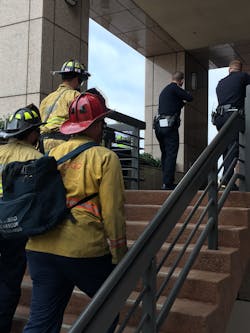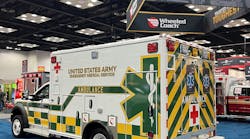According to an FBI study released in 2016, the threat of an active shooter incident—defined as one or more individuals actively engaged in killing or attempting to kill people in a populated area—is on the rise in the United States. In 2014 and 2015, there were 40 incidents spanning 26 states, resulting in the deaths of 92 people and injuries to 139 others. In the first 162 days of 2017, there were 149 mass shootings in the United States.1
This disturbing trend reinforces the need for first responders to adopt active shooter/mass-casualty incident (MCI) policies and procedures, and to judiciously train with law enforcement partners to effectively respond to this type of incident. The public safety community in San Diego has been very proactive in collaborating on policies and procedures as well as conducting realistic manipulative training sessions together. All of these efforts paid off on April 30, 2017.
Mass shooting at apartment
That Sunday evening, a lone gunman opened fire on a large group of people celebrating a birthday party at an upscale San Diego apartment complex swimming pool. By night’s end, eight critically wounded victims were transported by five ambulances to three different trauma centers in the San Diego area. One of the victims would later succumb to her injuries at the hospital. The lone suspect was fatally shot on scene by law enforcement.
The first-arriving San Diego Fire-Rescue Department (SDFD), San Diego Police Department (SDPD) and American Medical Response (AMR) units on the incident at the complex reacted swiftly and cohesively to a volatile and unpredictable emergency scene with multiple victims. SDFD’s Emergency Command and Data Center (ECDC) received a report from SDPD of two patients with gunshot wounds at an apartment complex in the University City area. Based on the information provided to ECDC, an engine and ambulance were dispatched to respond and stand back a safe distance until law enforcement cleared the scene.
While staging a safe distance from the complex, SDFD Engine 35 and AMR Medic 41 were met with an influx of wounded patients being transported away from the incident by the complex security guard. The fire officer on Engine 35 quickly recognized the situation as an active shooter incident/multi-patient incident (MPI) and assumed incident command from the remote location. The fire officer ordered additional resources while personnel on scene treated the wounded and loaded them in the ambulance for transport. The engine paramedic established Medical Communications (Med Com), made base hospital contact, and facilitated transport of the initial victims to the closest trauma center.
Factors for success
Several factors contributed to successful mitigation of this active shooter incident. SDPD’s helicopter was the first law enforcement unit on scene and quickly located the suspect in the pool area. They guided the first-arriving patrol units to the suspect’s location, and within minutes, the suspect was located and, upon firing at officers, eliminated. The rapid, coordinated efforts by SDPD units saved lives of civilians and responding public safety personnel.
Another factor was the situational awareness of the first-in fire officer on SDFD Engine 35, Captain Jonathan Frichtel. As first responders, we are trained to expect the unexpected, conduct a survey of the scene and create order out of chaos. This is exactly what Frichtel did. He quickly ordered more resources and directed personnel on scene to triage, treat and transport the wounded. All SDFD engines and trucks are staffed with a minimum of one paramedic. Remaining crewmembers are paramedics or EMTs. Engine 35 took advantage of having two paramedics on the apparatus to provide a higher level of care at this chaotic scene.
It is imperative that fire, EMS and law enforcement personnel have common communications capabilities and terminology. On this incident, familiarity with cross-agency communications was essential for exchange of information. SDFD personnel adeptly switched one radio channel to SDPD’s frequencies for the incident, and were able to maintain situational awareness of SDPD tactics. All SDFD units are equipped with a portable radio for each crewmember.
Command and control
In accordance with the National Incident Management System (NIMS), SDFD and SDPD established Unified Command (UC). Early in these types of volatile incidents, establishing UC can be extremely challenging because of the differing operational priorities of fire, EMS and law enforcement. In past active shooter incidents, first responders have been criticized for a lack of response resulting in significant delays in reaching, treating and transporting wounded victims. In October 2014, the San Diego Operational Area created a plan for these types of incidents and enacted its Active Shooter/MCI policy to facilitate a more coordinated, timely and effective joint response.
Active shooter policies and procedures allow for coordinated entry into the warm zone by establishing Rescue Task Forces (RTFs). RTFs are law enforcement and fire personnel formed into a team to enter the building or scene that is still being actively cleared and secured. Law enforcement provides force protection while fire personnel stabilize and treat victims. This can only be accomplished quickly and efficiently if UC has been established.
SDFD also has trained tactical paramedics who deploy with SDPD SWAT and can operate within the hot zone. In the event of an active shooter incident, SDFD tactical paramedics are another resource that commanders can deploy. In the San Diego apartment complex incident, the active shooter threat was eliminated immediately by SDPD, and RTFs and SDFD tactical paramedics were not required during this incident.
For decades, the SDFD has had an MCI/MPI policy to enhance the incident command system and facilitate effective scene management during an incident with multiple patients. An MPI is defined by SDFD as an incident with nine or fewer patients where expansion of the incident is not anticipated and department resources can effectively manage the incident. An MCI is an incident with 10 or more patients on an incident that has the potential to escalate or will require the resources of multiple EMS agencies.
The San Diego apartment complex incident was managed as an MPI because there were only eight patients, and SDFD and AMR were able to manage the incident with only City resources. In SDFD’s MCI/MPI policy, the first responder paramedic assumes the role of Medical Group Supervisor, and the first transport paramedic serves as the Transportation Group Supervisor. The remaining personnel on first-arriving units will establish the positions of Triage Unit Leader and Ambulance Staging Manager. As more resources, especially chief officers, arrive at scene, the incident command system should be expanded to support the needs of the incident.
Patient care
Early in the incident, Engine 35’s paramedic established Medical Communications. As Med Com, they established base hospital contact for the trauma center in the catchment area, and per San Diego County EMS protocol, utilized this base for the remainder of the incident. Med Com (E35 FF/PM) advised the base that AMR Medic 41 was en route to the hospital with three patients and fire personnel on board, and continued to coordinate the treatment and transport of patients off scene to local trauma centers. The swift removal of the first few patients away from the scene is a testament to established protocols, policies and training.
There are five trauma centers in the San Diego area. The closest trauma center to the incident was approximately two miles from the apartment complex. Having a robust trauma system certainly is an advantage for SDFD during a major medical incident. During this MPI, medic resources transported to the three closest trauma centers. Once Med Com is established, only one trauma center is utilized for communications with hospitals throughout the incident.
In San Diego, the Sort, Access, Lifesaving Interventions, Treatment/Transport (SALT) System is utilized to triage patients. All SDFD apparatus carry standard MCI kits, which contain the triage ribbon system, plastic color tape, triage tags and other miscellaneous trauma equipment. SDFD truck companies carry additional equipment, such as the colored tarps to set up treatment areas. SDFD has also incorporated the recommendations of the Committee for Tactical Emergency Casualty Care (C-TECC) in its treatment guidelines applying military medical lessons learned from the battlefield to high-risk civilian medical response situations. Combat Application Tourniquets (CAT) and combat gauze have been added to all MCI kits based on TECC guidelines.
Training is key
As noted above, many factors contributed to the successful mitigation of the active shooter incident at the San Diego apartment complex. However, one of the most important factors was the amount of training public safety personnel receive annually. SDFD personnel receive classroom and manipulative in-service trainings on MCI/MPI responses, decentralized battalion training on CAT, combat gauze and review of MCI command assignments. Continued training is required to maintain these perishable skills.
Most recently, the San Diego Operational Area Active Shooter policy has been practiced jointly in an in-service format with SDFD and SDPD. The EMS Division of the SDFD constructed a mock nightclub on the third floor of the EMS training facility. Crews from SDFD and SDPD were run through realistic training with lights flashing, loud music, smoke machines and multiple victims made to simulate the Orlando, FL, nightclub shooting.
Local large shopping complexes, schools and hospitals have conducted drills with SDFD, AMR and SDPD, providing further opportunity for San Diego public safety personnel to hone their skills on these low-frequency/high-risk incidents. Training together is clearly producing positive results on scene, and it was evident in the most recent incident.
Base objectives
The International Association of Firefighters (IAFF) position statement on active shooter events states that standard operating procedures (SOPs) should include at minimum the following objectives:
- Fire and law enforcement officers should establish a single command post and Unified Command
- Use of nationally accepted standards and operational protocols
- Use of the Rescue Task Force (RTF) concept for scene response
- Provide appropriate protective gear to personnel exposed to risk
- Law enforcement and fire departments should train together
- Use of common communications terminology
Prepared to respond
The San Diego apartment complex incident likely will not be the region’s last active shooter/multi-casualty or patient response to which local first responders and law enforcement will have to respond. However, with sound active shooter/MCI/MPI policies and procedures, a strong commitment to the use of NIMS region wide, common communications and terminology amongst response agencies, maintenance of a robust trauma system and an unwavering commitment by public safety leaders to ensure frequent quality training is available, San Diego is prepared to respond.
Reference
Gun Violence Archive: www.gunviolencearchive.org






